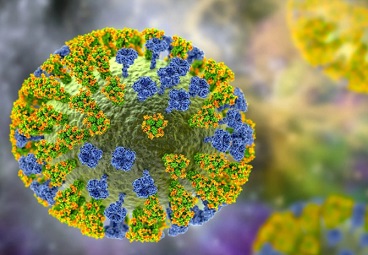New Published Study Reveals That A Strain Of H5N1 That Was More Resistant To Current Antivirals Was Killing Dolphins In Florida As Early As March 2022!
Nikhil Prasad Fact checked by:Thailand Medical News Team Apr 29, 2024 1 year, 8 months, 2 days, 17 hours, 1 minute ago
H5N1 News: The discovery of highly pathogenic H5N1 avian influenza in a common bottlenose dolphin in Florida has raised significant concerns about the potential impact of avian influenza strains on marine mammal populations. This incident, documented in March 2022, marks the first known case of such a viral infection in a cetacean within North America, shedding light on the broader implications of avian influenza beyond traditional avian hosts. The report was only just published a week ago in the Nature journal Communications Biology.
 Study Reveals That A Strain Of H5N1 That Was More Resistant To
Study Reveals That A Strain Of H5N1 That Was More Resistant To
Current Antivirals Was Killing Dolphins In Florida As Early As March 2022
Background and Context
Avian influenza viruses, particularly those of the H5N1 lineage, have garnered attention due to their impact on wild bird populations and domestic poultry. The emergence of highly pathogenic strains has led to widespread mortality among avian species, with occasional spillover events into mammalian populations as reported in the last 2 years in various studies, reports and
H5N1 News coverages.
While terrestrial mammals like seals and foxes have previously been affected by H5N1, the case of a bottlenose dolphin presents a novel aspect of interspecies transmission.
Pathological and Virological Findings
The investigation into the infected dolphin revealed significant neurological inflammation and necrosis, indicating a viral infection affecting the central nervous system. Virus isolation and genome sequencing confirmed the presence of H5N1, specifically belonging to clade 2.3.4.4b.
Insights from Molecular Analysis: Understanding Viral Adaptation
Genomic sequencing of the A(H5N1) strain isolated from the dolphin revealed intriguing insights into its genetic makeup. While lacking clear adaptations for mammalian transmission, the virus exhibited reduced susceptibility to certain antiviral drugs, raising concerns about potential therapeutic challenges in future zoonotic events.
Sequence analysis was conducted to identify markers related to mammalian adaptation. The analysis revealed the presence of an HA-T192I (H3 numbering) amino acid substitution in the 190-helix near the receptor binding site, which has been linked to increased receptor α2,6-sialic acid binding. However, the specific impact of this substitution on sialic acid specificity in this A(H5N1) genetic context remains unknown. Additionally, the NA-S246N (N2 numbering) substitution, which is associated with reduced susceptibility to the neuraminidase inhibitor (NAI) oseltamivir, was found in the A/bottlenose dolphin/Florida/UFTt2203/2022 (H5N1) virus. No markers indicating resistance to adamantanes or endonuclease inhibitors were detected. Furthermore, the absence of PB2 substitutions commonly linked with mammalian infection in avian influenza viruses was noted.
Antiviral Susceptibility
The A/bottlenose dolphin/Flo
rida/UFTt2203/2022 (H5N1) virus underwent evaluation for susceptibility to NAIs due to the NA-S246N substitution. Compared to the oseltamivir-susceptible reference virus A/Denmark/524/2009 (H1N1) pdm09, the A/bottlenose dolphin/Florida/UFTt2203/2022 (H5N1) virus exhibited an 18-fold decrease in oseltamivir susceptibility, with IC50 values of 7.51 nM vs. 0.41 nM, respectively.
For comparison, the reference virus A/Denmark/528/2009 (H1N1)pdm09 containing NA-H274Y (N2 numbering) was also assessed and exhibited significantly reduced inhibition by oseltamivir and peramivir, with IC50 values of 155.0 nM and 23.5 nM.
In summary, the presence of NA-S246N in A/bottlenose dolphin/Florida/UFTt2203/2022 (H5N1) resulted in decreased susceptibility to oseltamivir, aligning with the World Health Organization (WHO) guidance for NAI susceptibility reporting on the lower end of the inhibition scale.
Transmission Dynamics and Environmental Context
The precise route of transmission to the dolphin remains speculative, although environmental exposure to infected birds or direct interaction with avian carriers is considered plausible. The proximity of marine mammals to avian habitats, coupled with behaviors like predation or scavenging, increases the likelihood of viral transmission.
Implications for Marine Mammal Health and Conservation
The detection of avian influenza in a dolphin underscores the need for continued surveillance and monitoring of marine mammal populations. Understanding the potential for viral spillover and adaptation in non-traditional hosts is crucial for both wildlife health and human public health concerns.
Comparison with Previous Avian Influenza Cases in Marine Mammals
Historically, avian influenza infections in marine mammals have exhibited neurological signs and CNS involvement, similar to the findings in the infected dolphin. However, the susceptibility and transmission dynamics in cetaceans remain areas of ongoing research and investigation.
Public Health Considerations
While the current risk of H5N1 to human health is low, the potential for viral adaptation and enhanced replication in marine mammals raises concerns about future zoonotic risks. Vigilant surveillance, biosafety protocols, and antiviral research are essential components of mitigating these risks.
Conclusion
The case of H5N1 avian influenza in a bottlenose dolphin highlights the complex interplay between viral pathogens, wildlife populations, and environmental factors. Continued research and collaboration across disciplines are essential for addressing emerging infectious disease threats in marine ecosystems.
Recommendations for Future Research and Monitoring
-Comprehensive surveillance of avian influenza strains in marine mammal populations.
-Investigation into potential host adaptation and transmission dynamics of avian influenza in cetaceans.
-Development of antiviral strategies tailored to marine mammal species.
-Integration of wildlife health considerations into broader public health and conservation frameworks.
Final Thoughts
The case of H5N1 avian influenza in a bottlenose dolphin serves as a reminder of the interconnectedness of ecosystems and the need for proactive measures to safeguard wildlife and human populations against emerging infectious diseases. Through ongoing research, surveillance, and collaboration, we can better understand and mitigate the risks posed by zoonotic pathogens in marine environments.
What is concerning however is the fact that authorities and scientists in the United States are not publicly sharing critical data and study findings timely with the others. Many revelations are only coming to light months or years later!
The study findings are found here:
https://www.nature.com/articles/s42003-024-06173-x
For the latest
H5N1 News, keep on logging to Thailand Medical News.
